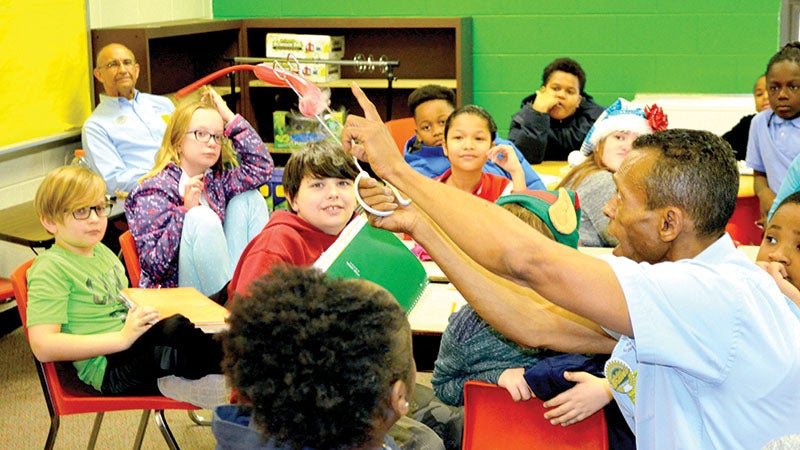STEM study educates and entertains
Published 10:34 pm Thursday, December 28, 2017

- Virginia Air and Space Center Science Educator Parrish Crosby demonstrates the effects of liquid nitrogen on balloons to Nansemond Parkway Elementary School fifth graders in the Stem 360 program.
Educators from the Virginia Air and Space Center showed a class of fifth-graders from Nansemond Parkway Elementary School some interesting uses for liquid nitrogen on a Saturday earlier this month.
VASC Science Educator Parrish Crosby walked around the classroom with a hissing glass of the super-cold liquid. He froze a partially filled Gatorade bottle, and balloons shriveled as he dipped them in the glass before regaining shape as he pulled them out.
Wearing holiday hats in anticipation of Christmas break, the students were excited, intrigued and, most importantly, learning.
“We as educators make it entertaining as well as educating,” Crosby said. He called it “edutainment.”
“As long as we can make it fun, then it resonates a lot better than doing something strenuous or difficult.”
These students have been part of an ongoing research study since they were fourth-graders.
In collaboration with the Institute for Learning Innovation, VASC has been conducting “STEM 360,” a two-year, immersive, multi-platform investigation into the possibilities of influencing the engagement, workforce awareness and attitudes of fourth- and fifth-graders in the areas of science, technology, engineering and math.
VASC and the institute have been providing educational outreach, field trips, coaching and ambassadorships for students and families to embrace these subject areas.
The research includes 1,500 Hampton Roads students from the beginning of their fourth-grade years to their fifth-grade graduations.
“We are pleased to be partnering with Dr. (Deran) Whitney, superintendent of the Suffolk school division, on this important research involving 516 current Suffolk fifth-grade students,” Bob Griesmer, VASC executive director and chief executive officer, stated in an email.
Griesmer further stated that the program was made possible with support from Delegate Chris Jones, “who with the support of Sen. (Tommy) Norment appreciates the need for grassroots programs that make a difference in children’s performance on SOL tests and attitudes toward potential careers in STEM related fields.”
Approximately 80 NPES fifth-graders in the program had multiple opportunities to learn about science, technology, engineering and math outside their classrooms this fall.
They learned about unstable structures and tectonic plates at the Virginia Beach Marine Science Museum and visited Norfolk Botanical Garden, where they learned about becoming biologists.
“The idea is to get them thinking about science career fields, even at this age,” said Lead Educator Ellis Hatcher, who was at the lesson on Dec. 18 with Crosby and Tiffany Clark, an educator in training.
Fifth-grader Robert Bemisdarfer, 10, said the field trips and lessons helped spur his interest in robotics.
“I’ve always wanted to become like a programmer, so that I could build my own robots and program it to do certain things,” Robert said.
NPES Academic Coach and STEM 360 Coordinator Kimberly Nierman said hands-on experiences help make the lessons memorable.
“If they have an experience that they can connect it to, then they’re going to remember it a whole lot better than just talking or reading about it,” Nierman said.
Andrew Perkins, 11, said his favorite field trip was going to iFly Virginia Beach Indoor Skydiving.
“You go into a big circle where there was air blowing up out of the big wire net, and it would levitate you,” Andrew said. “They had the kids going four-ish feet above the ground. It was pretty fun.
Olivia Adkins, 11, recalled visiting VASC and getting the opportunity to spacewalk.
“It was supposed to be an experience of what it was like to live in space,” Olivia said. “It was a blow-up chamber and there was just air inside, like we were in a giant bouncy house.”
Some of the students were surprised by what astronauts had to do to live in space, especially their peculiar diets.
“I thought it was pretty amazing, because I always thought you could eat whatever you wanted,” Andrew said. “It turns out you couldn’t eat anything with crumbs, because they could get into control units and stuff.”
“One crumb could ruin the whole ship,” Robert added.





